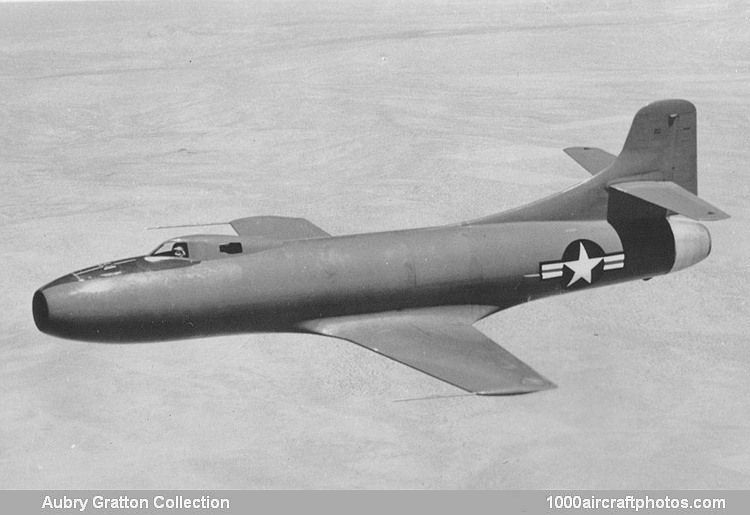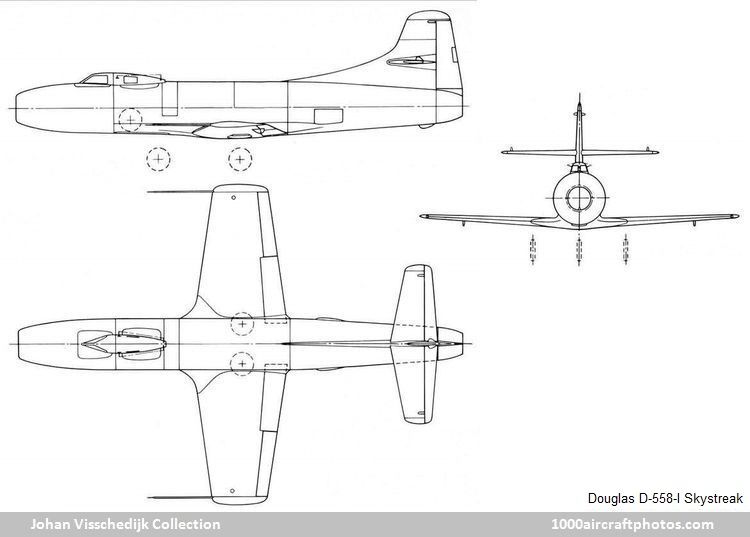In spite of the conflicting requirements, which in part were offset by an early agreement on the use of a turbojet as power plant, the two organizations concluded in the latter part of 1944 that the aircraft should be (1) unencumbered by military requirements, (2) capable of taking-off and landing on its own power, (3) designed to carry a pilot and up to 500 lb (227 kg) of test instrumentation, and (4) able to obtain the maximum speed possible with existing power plants.
The Navy and NACA, however, were still not yet ready to circulate official specifications. None the less, L. Eugene Root – Chief Aerodynamicist for Douglas El Segundo – was able to obtain preliminary information during a routine visit to the BuAer in late 1944. The information was of considerable interest and Douglas decided to submit a proposal to the BuAer. Under the general supervision of Ed Heinemann and Leo Devlin, a team led by Project Engineer Robert Donovan prepared a preliminary proposal for the smallest aircraft which could be designed around the most powerful engine then available, the General Electric TG-180 turbojet, and still meet Navy and NACA requirements.
In February 1945 engineering proposals for the Douglas Model 558 High Speed Test Airplane were transmitted. Two months later, on April 13, Douglas submitted a contract proposal covering six aircraft, recommending that four TG-180 powered aircraft (three with side air intakes and one with nose intake) be completed with wings using a NACA airfoil having a 10% thickness-chord ratio, while the last two aircraft, also powered by a TG-180 and fitted with side air intakes, were to have respectively thinner and thicker airfoils. Douglas further proposed that at a later stage two of the aircraft be modified by replacing the original TG-180 engine with a smaller Westinghouse 24C turbojet and by adding a rocket engine.
The initial models were intended to investigate the region between Mach 0.75 and 0.85 from sea level to approximately 40,000 ft (12,195 m) whereas the modified aircraft were to test the Mach 0.85 to 1.0 envelope and reach higher altitudes. Furthermore, fearing that a pilot would not survive a conventional ejection, Douglas designed a jettisonable nose section, including the cockpit, from which the pilot could bail out once the nose section reached slower speeds after its separation from the crippled aircraft.
Following NACA's and BuAer's favourable review of the Model 558 proposal, Douglas was awarded on June 22, 1945, a Letter of Intent under Contract NOa(s) 6850, three development phases being covered. Phase One called for the design, construction and testing of six TG-180 powered aircraft; Phase Two specified the modification of two aircraft for turbojet-cum-rocket power plant; and Phase Three concerned the proposed design and mockup of a combat type.
Initial mockup inspection took place between 2 and 4 July, 1945, and resulted in NACA requesting that the canopy be redesigned and that side air intakes no longer be considered. A follow-on mockup inspection was held during August 14-17 and, at that time, the program was redirected to provide for two separate projects. The initial D-558-I project, based on the original straight-wing, turbojet-powered design and intended for transonic research, was now to be followed by a D-558-II design with swept wing and turbojet-cum-rocket power for research in the supersonic regime. From that point on, the design of the two D-558 models proceeded separately.
To reduce risks and uncertainties, the design of the D-558-I was kept as conventional as possible and, upon being completed in April 1947, the aircraft emerged as a low-wing, unswept, monoplane with a cylindrical-section fuselage designed around a nose air intake, a bifurcated air duet around the cockpit and straight-through jet exhaust. The 5,000 lb (2,268 kg) thrust J35-A-11 engine, an Allison-built version of the General Electric-designed TG-180 turbojet, was installed in the center fuselage and was fed from integral wing tanks with 230 gal (871 l) capacity. In addition, provision was made for two 50 gal (189 l) wing tip tanks.
Other notable design characteristics included the use of specially designed, high-pressure tires, the mounting of the inflight-adjustable tail plane half-way up the fin, and the addition – a last moment modification requested by the test pilots – of speed-brakes mounted externally on either side of the fuselage just aft of the wing.
Painted scarlet and named Skystreak, the first D-558-I (c/n 6564, BuNo. 37970) was trucked to Muroc Dry Lake in April 1947 for the first phase of its manufacturer's trials. On April 15, Eugene F. May took the aircraft on its first flight but immediately had to cut the test short due to a partial power loss. On landing, the aircraft's left wheel brake disintegrated. Six days later, a second attempt ended with similar troubles and the unlucky prototype was grounded for four weeks.
On its return to flight status, it continued to run into troubles as it was plagued with persistent landing gear retraction problems. Finally, however, the various deficiencies were remedied and by mid-July 1947 the aircraft was ready for general handling and high-speed trials. At that time, the original clear canopy was replaced by a hooded covering with a flat V-windshield, which was so narrow that pilots had to wear helmets covered with chamois leather to prevent scratching the transparency.
In early August 1947, by which time BuNo. 37970 had reached a top speed of Mach 0.85, the second D-558-I (c/n 6565, BuNo. 37971) was ready to join in the trials, and Service pilots began to share the task of flying the aircraft. As flight time slowly built up while the aircraft's handling characteristics and performance were systematically explored, confidence in the Skystreak increased steadily and the Navy decided to use the aircraft for an attempt on a new world airspeed record.
Accordingly, Commander Turner Caldwell, the Navy project officer, flew BuNo. 37970 on August 20, 1947, and averaged 640,663 mph (1,031.049 km/h) during four passes over a low-level 3 km course to break the 623.738 mph (1,003.811 km/h) record set a month earlier by Col Albert Boyd in the specially modified Lockheed P-80R. However, Caldwell's record held for only five days as, on 25 August, Major Marion Carl, a Marine pilot, flying the second Skystreak averaged 650,796 mph (1,047.356 km/h).
Following these record flights, the first D-558-I was returned to its contractor program and completed a total of 101 flights prior to being delivered to NACA on April 21, 1949. It was coded NACA "140", however, it was never flown by NACA but was used by this agency to provide spares needed to support the trials of the third D-558-I. The second Skystreak, the holder of the world airspeed record, completed 27 flights in the hands of Navy and Marine and company pilots before being handed over to NACA on 23 October, 1947, coded NACA "141".
Upon being fitted by NACA with special instrumentation, NACA "141" made two further flights in November 1947 with NACA's pilot Howard C. Lilly at the controls, but winter flooding of the runway and the need for engine maintenance resulted in an eleven-week grounding. Preceded by a single flight during the month of February, the intensive flight trial program planned by NACA began on March 31 but, within five weeks, the aircraft crashed and Howard Lilly was killed. This accident, the first in which a NACA pilot lost his life while on duty, occurred on May 3, 1948, when during the aircraft's 46th flight the engine compressor disintegrated shortly after take off.
The crash of the second Skystreak and the death of its pilot delayed the NACA research program by almost a year, although the third D-558-I (c/n 6566, BuNo. 37972) had been delivered in November 1947 and had been flown four times by Douglas pilots before being handed over to NACA, coded NACA "142". During most of 1948 and into April 1949, the third Skystreak remained grounded while the accident to NACA "141" was being investigated. Eventually, the inquiry exonerated the Skystreak and NACA "142" was returned to flight status, making its first NACA flight on April 22, 1949.
A total of 77 additional flights were made by seven NACA pilots, enabling the agency to obtain and quantify much useful data on high-subsonic handling. Finally, the aircraft made its 82nd and final flight on 10 June, 1953, to complete the Skystreak's four-and-a-quarter years of active research flying. The first Skystreak is preserved in Navy markings at the Naval Aviation Museum in Pensacola, Florida, while the third Skystreak was initially held at the Marine Corps Air-Ground Museum at MCAS Quantico, Virginia, but is presently preserved in NACA markings at the Carolinas Aviation Museum in Charlotte, North Carolina."

